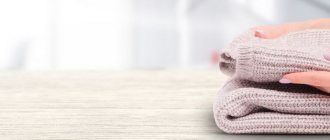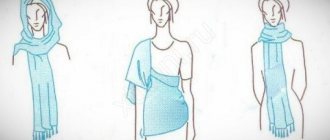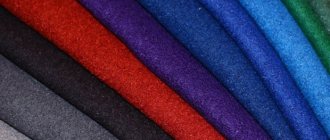Since ancient times, every woman has wanted to have a cashmere shawl made from real goat down in her wardrobe. The product was threaded through the ring - if it passed easily, then the quality of the material was high.
Cashmere is a yarn obtained from goat hair. Just like mohair, it is worth its weight in gold, and even more: it is called “wool diamond”. Things made from Kashmir down are of high quality; they serve as an indicator of a person’s good status. Prestigious material is sold in Asia, Europe and America.
Cashmere is made from the wool of Tibetan goats, which live in the mountainous regions of India, Mongolia, Pakistan, and China. As in the case of Angora goats, when the climatic zone of grazing animals changes, the fleece loses most of its unique properties. It was the characteristics of the mountainous terrain that influenced the formation of the unique properties of this yarn. Temperatures in these areas range from - 40 to + 40 °C. In order to protect themselves from such changes, goats have two layers of hair - fluff on the inside and wool on top.
Historical fact. The fashion for cashmere shawls was brought to Europe by Napoleon, who gave Josephine a wonderful pashmina.
Properties of cashmere
Unlike Angora goats, Tibetan goats are not sheared, but are combed during the spring molt. Moreover, the resulting 150–200 grams of raw material is unrefined cashmere.
After processing the fluff, there remains half as much fluff. This is why cashmere is so expensive. The undercoat of goats is highly valued in the consumer market; it is specially combed and used to create fabrics and yarn. One goat produces very little fluff; it is impossible to knit even a scarf from this amount. Cashmere thread is very thin, thinner than a human hair. It is woven only by hand. Painting is also done mainly by hand. Due to the cavities inside the hair, cashmere yarn is much warmer than wool.
The raw materials are soft and tender. It is often mixed with other fibers to give products greater strength and elasticity. Natural shades include white, brown, gray and black.
- Cashmere outweighs sheep's wool.
- Delicate threads are suitable for hand and machine knitting.
- The material does not irritate sensitive skin.
- No pellets are formed on the finished canvas.
- The items are comfortable to wear.
How do you get it?
Cashmere is the down of mountain goats, and of a special and quite rare breed. Down is collected only once a year - in the spring. Moreover, they do not cut or shave, like wool, but pluck or comb out. The name of the fabric originates precisely from the area of breeding of these animals - the principality of Kashmir on the island of Hindustan in India.
One animal gives approximately 200 grams. The fluff is subsequently processed to make yarn and the volume is reduced. This is why cashmere is considered one of the most expensive fabrics in the world - there are too few raw materials.
REFERENCE: Goats of this breed live exclusively in the Himalayas. Attempts to breed the breed in Asian countries were unsuccessful.
The fluff is spun into yarn entirely by hand. Coloring is also done by hand. The natural colors of the yarn are white, gray, black and brown, matching the color of the goats. That is why the fabric received such high-profile names as “wool diamond” - there are too few raw materials, and the processing is exclusively manual.
Cashmere varieties
The cost of cashmere is determined by the thickness and color of the hair. Pashmina, in which the fluff fibers are no more than 15 microns thick, is the undercoat combed from the belly and neck of the goat. Cashmere or semi-pashmina with a fiber thickness of more than 15 microns. One of the most expensive types of cashmere is worsted yarn, this is a fiber processed by a comb. This treatment removes all roughness and short fibers.
Cashmere yarn
Soft and delicate fluff produces a fragile cashmere thread, so it is always mixed with others. The natural color of cashmere is white, grey, brown or black. But any color has a characteristic smoky shade. The most expensive is undyed yarn. In any case, cashmere is matte, it cannot be bright and glossy. Cashmere yarn is quite elastic and does not pill. The more tightly the thread is twisted during spinning, the softer and lighter the finished product is. Cashmere thread is very light. And in softness this material is superior to silk.
The best patterns for knitting from yarn with cashmere on the People Knit website.
Properties and composition of cashmere
Unique properties are determined by the raw materials from which the fabric is woven.
What is cashmere fabric made from?
The fluff of Kashmiri mountain goats is used for production. It is obtained manually, that is, the excess undercoat is combed out during the molting period. The most valuable raw material is considered to be the down of goats living in India and Mongolia.
The climatic features of the region contribute to the formation of undercoat with certain properties. Natural cashmere has a number of advantages:
- Low thermal conductivity. The hollow structure of the fibers retains air, which allows you to retain heat. The heat-protective properties are many times superior to wool.
- High strength. Despite the porous structure, the fibers are elastic and durable. It practically does not wrinkle and retains its shape well.
- Soft, delicate structure. Cashmere thread is many times thinner than silk and even human hair. It is soft and causes pleasant tactile sensations.
- High hygienic properties. Comfortable to wear, breathable, hygroscopic.
- Hypoallergenic. Natural fibers of animal origin do not cause itching or irritation of the skin.
Disadvantages include high cost and high maintenance requirements. In addition, pellets may form on the surface.
Color and dyeing features
Natural color indicates high quality. Goat down is weakly colored, the dyes quickly lose their brightness, so the fabric takes on a faded, slightly smoky shade.
Dyed fibers become less soft and elastic. Therefore, they try not to dye cashmere. Most often, the canvas retains its natural, slightly muted color. It matches the colors of Kashmiri goats: white, smoky gray, beige, dark brown.
What you need to know about the composition
Natural cashmere contains 100% goat down. To produce high-quality threads, the best raw materials are selected: long, thin fibers. Sometimes manufacturers use short, loosely twisted threads, which saves on the cost of raw materials.
As a result, the fabric retains increased softness, but becomes less dimensional stable. In addition, it is allowed to use cashmere thread with the addition of wool (20-40%).
Natural cashmere is an expensive material. To reduce cost, cashmere threads are mixed with different types of fibers. At the same time, a heterogeneous composition does not indicate low quality.
On the contrary, manufacturers are trying to improve some properties. For example, silk threads add shine and strength, and the addition of wool reduces pilling.
The composition of cashmere fabric in mass production is varied, the main components are:
- wool;
- silk;
- viscose;
- polyester;
- acrylic.
Recently, artificial fabrics imitating cashmere have become widespread. For their production, exclusively chemical fibers (polyester, acrylic, viscose) are used. In terms of aesthetic and hygienic properties, it bears little resemblance to natural.
Wash
Cashmere items are recommended to be washed by hand in cool water, the temperature of which does not exceed +30 °C. You can add baby shampoo or powder to the water. Stains on clothing are pre-treated with soap, and only after that the item is soaked in a soap solution for 20–25 minutes.
After rinsing the knitted item under running water, you can leave it in the sink for a while to let the water drain.
Push-ups are not recommended. Drying the product on a clothesline is also impossible; it is best to lay it out on a horizontal surface.
Rules for caring for cashmere clothing
Since cashmere is classified as an elite fabric and is highly expensive, I would like to extend its service life as much as possible. Thanks to its properties, clothes retain their luxurious appearance even after prolonged wear. If you care for cashmere properly, no problems will arise.
Careful storage. Cashmere items should not be worn; they should be given rest. Clothes are stored flat on hangers; they should not come into contact with other things. Soft bulky hangers are recommended. If pellets appear, you need to wash them: the fluff will unravel and regain its original appearance.
Wash. The delicate material does not tolerate exposure to alkalis and acids; it is necessary to choose mild detergents. If you don’t have powder or gel for wool items on hand, you can replace them with baby shampoo. Cashmere items are washed by hand at a water temperature of 30 degrees. Do not twist or squeeze too hard. It is recommended to blot the wet item with a terry towel to prevent water from running off.
Drying. Cashmere items are not hung to dry, otherwise they will stretch and lose their original shape. The wet product is laid out on a horizontal surface, having previously placed a soft fabric base. It is necessary to choose a place where sunlight does not fall.
Ironing. It is best to use a steamer for ironing. Immediately after treatment with hot steam, clothes are hung on hangers; they should hang down within 30 minutes.
Ironing is not recommended, but if there is no other option, you need to use an ironing pad. This can be any soft cotton cloth or gauze. It is also necessary to set the correct temperature according to the wool.
If you like to sew, read our instructions on choosing fabrics for a summer dress and materials for different types of skirts. A competent approach will help you get designer clothes at home without extra expenses.
Storage
Cashmere clothing should be stored in a dry and dark place, since humidity and direct exposure to ultraviolet radiation have a detrimental effect on the material. A plastic bag or special wrapping paper will help protect products from dirt and dust.
Unfortunately, you and I are not the only ones who find cashmere items attractive; moths also do not ignore them. Therefore, when storing, do not forget to add special insect repellent.
What is knitted from cashmere
If you want to emphasize your business style, cashmere will come in handy. It is used for knitting women's and men's items.
Classic always remains in fashion, and together with noble cashmere you will be irresistible. Is not it so?
Let's not forget about our men.










